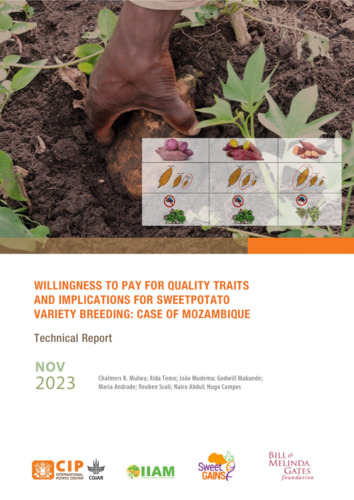Willingness to pay for quality traits and implications for sweetpotato variety breeding: case of Mozambique
Abstract
Despite decades of research and dissemination of improved sweetpotato varieties, uptake at scale remains low and envisaged development goals of food security and livelihoods remain elusive. This is despite demonstrated impacts of such technologies in combating food and nutrition insecurity, amidst global challenges like climate change. Growing evidence show that end-user acceptance of improved varieties is critical in the widespread adoption of such varieties, and inclusion of the heterogenous preferences of diverse sets of end-users in the variety development process is therefore critical. With global changes in weather and consumption patterns, end-users are now demanding varieties that are more suitable to their unique consumption needs, production environments, new market demands and have desired processing characteristics. Such dynamics in demand have necessitated rethinking of breeding programs from the traditional focus on agronomic gains such as increase in yields and yield protection, to consideration of more nuanced quality-related traits that appeal to targeted populations.
Against this background, this study sets out to explore the decision-making behavior of Mozambican sweetpotato producers in variety selection, and the implicit value placed on different sweetpotato traits, including the often ignored but crucial quality traits. The aim of the study is to identify the economic valuation of such traits and how they are traded off in variety selection decisions, to allow for prioritization in breeding efforts. To achieve this, an exploratory sequential design in a predominantly quantitative mixed-method design was adopted for the study. First, based on the insights from a gender disaggregated qualitative assessment among sweetpotato growers and consumers and in consultation with breeding experts from Mozambique, the most preferred sweetpotato variety traits in the regions of study were established. These traits were then utilized in the design of a choice experiment, implemented among 860 sweetpotato producers spread across four sweetpotato growing regions in the country. Finally, a generalized multinomial logit model was used to estimate implicit economic valuation of each of the considered trait, as well as heterogenous valuation of such traits across gender, education and age of respondent groups.
Results from the study show that producers have a high preference for quality-related traits, with preference for Vitamin A being higher than that for drought tolerance, while dry matter content is valued about the same as drought tolerance. While scoring significantly lower than Vitamin A, drought tolerance and dry matter content, other quality-related traits like root size and sweet taste also have significant positive values implying their importance in informing sweetpotato variety choice. In terms of gender heterogeneity, flesh color is highly valued among the women sub-sample. The study identifies Vitamin A, dry matter content, sweet taste, and medium to big root size, as the key preferred quality traits in Mozambique, in that order. The results imply that these quality traits should be pursued as a suite in breeding objectives, in combination with essential agronomic traits such as high yields and drought tolerance, for higher acceptance and demand of improved sweetpotato varieties across the country.

